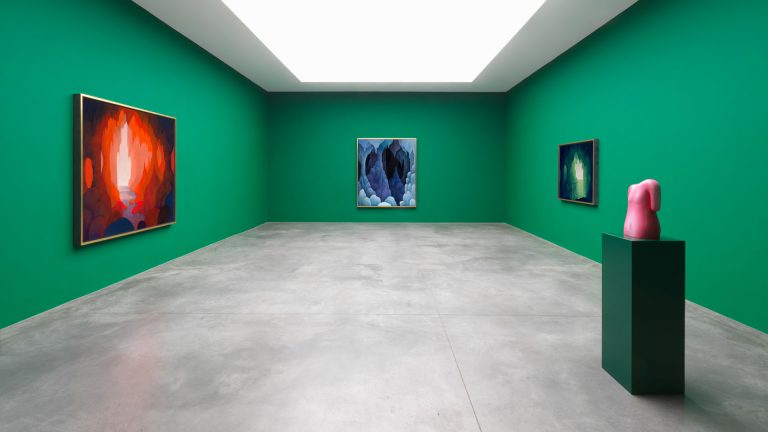Artist: Mohamed Namou
Exhibition title: E.P. (EXTENDED PLAY
Venue: LEVY.DELVAL, Brussels, Belgium
Date: September 11 – October 24, 2015
Photography: images copyright and courtesy of the artist and LEVY.DELVAL, Brussels
In Manic Miner, a video game created in 1983 by Mathew Smith, the player has to go through a series of underground networks divided into 20 levels in order to complete the script. The title of each level has either a metaphysical or sci-fi accent that goes counter to the flat and basic construction of its gameplay. The player starts with the Central Cavern, make a quick detour through The Endorian Forest and end up in the Solar Power Generator. Developed in 6 days, it is considered in the history of video games as one of the first blockbuster. The disappearance of its creator gave the final touch to the video game’s myth. on data mining. As the subterranean labyrinth that the player as to go through in Manic Miner, most of Mohamed Namou’s work revolves around information foraging.
Manic Miner is used in the central installation Extended Play as an allegory of the Phreakers community: a group of hackers started by David Condon that specialized itself in manipulating the telecommunication system. Via the utilization of electronic tone generators that mimicked the system of tones used to route long-distance calls, they find a way to make free calls all over the world. Achieving a proto global brain utopia, this community soon evolved into what we know as the hackers with the advent of computerized phone systems. Released the same year as Manic Miner, The Psychology of Human-Computer Interaction written by the influential American researcher Stuart K. Card is a groundbreaking foray into the science of user interface. Part of the Xerox PARC team, known for being a leading catalyst of the 70’s for the Silicon Valley development, he has made a significant contribution in the cognitive ergonomic of digital data. Instead of thinking how a human and a computer could interact together, he conceptualized this relationship as two information-processing systems speaking together. This question is at the core of Electric Dreams which plot follows the platonic love between a computer and a cello player. The relationship culminates in a few sequences in which both of them are rendered as a synchronized melodic entity.
These two scenarios are articulated around a human-computer interaction that is either stigmatized in the case of the phreakers or considered has deviant for Electric Dreams. In both situations, information-processing device are portrayed as something corruptive. This was before the human intelligence becomes addicted to the infinite computation. In the post 2008-era cognitive capital has superseded social capital. The creepy voice of the computer featured in Electric Dreams has been replaced by Scarlett Johansson voice in Her. Dieter Rams did a great job in erotizing every electronic device. There are neither a techno utopianism movement left nor a 21th century equivalent version of the Luddites. We live in a condition of digital obesity. In 2020, 25 billion connected “Things” will be in use according to Gartner. This evolution has not suppressed the fear of computers, it has replaced it with a lingering cyber paranoia. AIDA, an artificial intelligence initially developed by IBM in order to identify Russian missile in space is now used by retailers to “recapture possible store defectors in a pre-emptive strike before they start shopping elsewhere”. At this rate the technological singularity will just be integrated in an OSX update. There will be no primitive scene or a moment to look back at and mourn at your pre-singularity condition. Despite the recent warning against A.I jointly issued by Stephen Hawking, Elon Musk and Bill Gates, there is a great deal that you will not even notice it’ presence.
Mohamed Namou’s interest in the iconography that surrounds A.I is coupled with a more abstract series of work that deals with data visualization. The series of sculptures Sam and Al reproduce the anatomy of a printing machine via the use of granite and stereogram. Initiated in 2012, this work is a comparative examination of mineral and data depth. Stereograms are 3D images that have been flattened.
The set of patterns only forms a three-dimensional image when viewed close-up with the eyes focused at infinity. They are used in order to create the illusion of depth while on the other hand granite are a maelstrom of depth obtained thought a continuous accumulation of diverse type of magma. The title references Code Quantum’s two main protagonists Sam and Al who are represented on the stereogram. Beyond this sci-fi buddy narrative between a scientific time traveller and his long time partner lays an accurate vision of our digital environment according to Namou. Like the razzle-dazzle effect of Asian megacity, the stereograms are ultimately pure data contortion.
In The alchemic digital, the planetary elemental, Jussi Parikka details the branding of minerals by digital companies. In that context the shine obtained through the alloy of aluminium and metal become the ultimate step within an “optical economy typically (mis)understood as being purely cognitive or immaterial.”. The material ecology that explores Mohamed Namou has been steadily concerned with the visual culture of minerals from Ron Arad curved design chairs to Bang & Olufsen’s promise of an ultimate technological experience. Thus, they emphasize all the spiritual qualities that are marketed by such products: simplicity, purity, immateriality, perfection and cultural neutrality. Ultimately, Mohamed Namou’s work is investigating the history of digital materiality and the business of transforming aluminium device into tactile enlightenment.
– Charles Teyssou, 2015
Mohamed Namou, E.P. miner (Electric Dream), 2015
Mohamed Namou, Sam, leap 1, 2015
Mohamed Namou, E.P. basic (Electric Dream), 2015
Mohamed Namou, Al, leap 2, 2015
Mohamed Namou, Al, leap 1, 2015




















